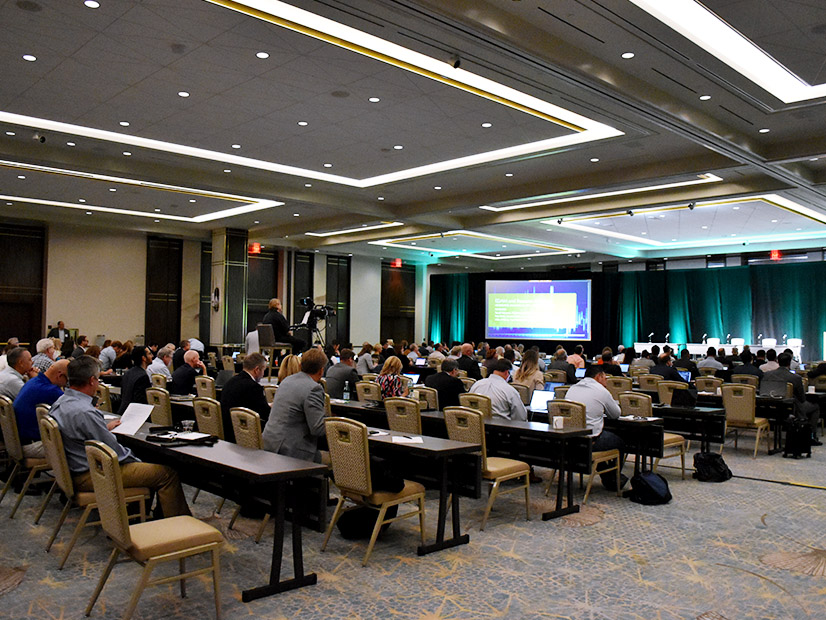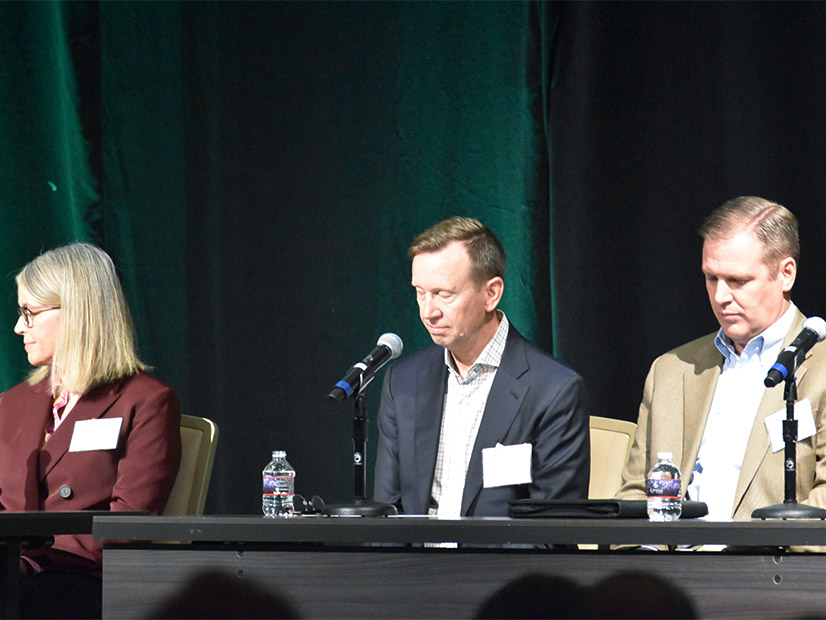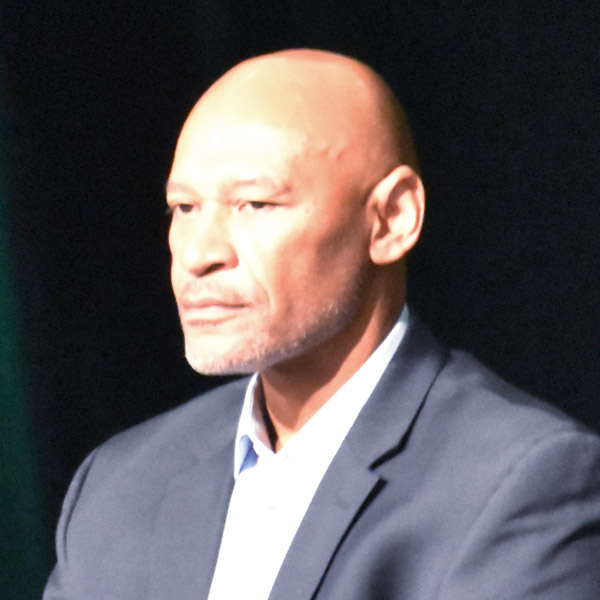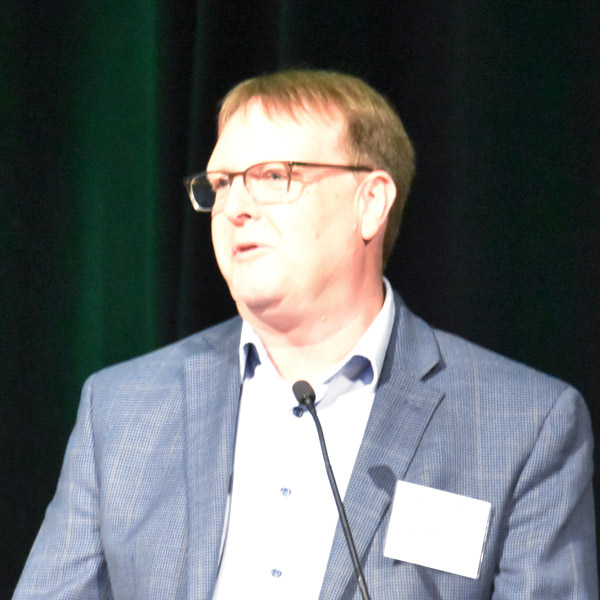LAS VEGAS — The stars may not yet have aligned in favor of CAISO in the contest to bring an organized electricity market to the West, but key players in the industry appeared to be doing just that last week at an ISO event to celebrate the progress of its Extended Day-Ahead Market (EDAM).
Wednesday’s EDAM Forum at Resorts World on the Las Vegas Strip attracted 240 in-person attendees and about 300 participants online, a CAISO official said. The packed agenda included a CEO roundtable, a panel of Western utility commissioners, an in-depth presentation on potential EDAM benefits and a discussion about evolving markets in the West.
The ISO convened the forum just a week after CAISO submitted to FERC its EDAM tariff and associated day-ahead market changes designed to increase rewards for flexible resources and reduce load imbalances between the day-ahead and real-time markets. (See CAISO Files EDAM Proposal with FERC.)
And, accidentally or not, the event also coincided with two important developments.
The first was a notice issued by the coalition of utility regulators who this summer proposed the creation of a Western RTO that would be independent of CAISO’s governance while still building on the ISO’s Western Energy Imbalance Market (WEIM) and the EDAM. The document outlined an aggressive timeline for developing the governing framework and seating a board of directors for the new entity, signaling that the backers are moving urgently to build a market structure that ensures the participation of California and increases the likelihood of a single, seamless Western market. (See Backers of Independent Western RTO Seek to Move Quickly.)
The second was the Balancing Authority of Northern California’s (BANC) announcement that it will advise its publicly owned utility members to join the EDAM over SPP’s competing Markets+ day-ahead offering. Accompanying that was a parallel announcement that the board of BANC’s largest member, Sacramento Municipal Utility District, approved the utility’s request to join the EDAM. (See BANC Moving to Join CAISO’s EDAM.)
Scott Miller, executive director of the Western Power Trading Forum, expressed surprise at what he saw at the event.
“This really changes the calculus of my thinking around” Western markets development, Miller told RTO Insider immediately after the forum concluded.
“It was the general positivity — even from CEOs whose folks are involved in Markets+ — that struck me as interesting,” Miller said later in an email. “The fact that a ‘shared governance of EDAM with CAISO’ might be acceptable was a bit of a shift, although the shared governance might prove a problem in an RTO setting where transmission operations are turned over to the RTO.”
‘Tremendous Benefit’
During the CEO roundtable, Pacific Power CEO Stefan Bird explained why the utility’s parent, PacifiCorp, the first entity to join the WEIM in 2014, also decided to become the first participant in the EDAM.
“We want to use as much renewable power that’s free — has no fuel cost — as much as possible and avoid those emissions,” he said.
“I was part of that group running around the West, I don’t know, 10-plus years ago, and dreaming about … how cool it would be if we could just coordinate better and be more efficient in how we leverage the abundance that we have across the West, and so proud of how far we’ve come and excited about the next steps,” Bird said.
Idaho Power CEO Lisa Grow offered “profound thanks” to CAISO for developing the EDAM.
“I have been in this industry for 36 years, and I have participated in every single effort we’ve had to create an RTO, or some sort of organized market, and we just never quite got there,” she said. “I think that the demonstration that we can take incremental steps is the only thing that we’ve seen work.”
Grow said the industry’s transition to clean energy will require the region to “optimize the system we have.” She also questioned whether there’s a need for a full RTO — at least in the near term.
Idaho Power doesn’t “have legislative or PUC-mandated things that we have to do towards an RTO, so we can kind of watch how this goes,” she said.
NV Energy CEO Doug Cannon gave a “shoutout” to CAISO for its responsiveness in developing a WEIM rule change that allows a participant that fails the market’s resource sufficiency test during a trading interval to acquire energy within the market rather than just being shut out.
“That’s a tremendous benefit,” Cannon said. “What we were concerned about is, you’ve got somebody who’s already kind of down. Why are we pushing them further down by not letting them get access to this broader market? Instead, as a West, let’s come together and give that person an option to pick [energy] up. Now, they have to carry their weight, they’ve got to pay the price, but let’s help them through that challenging time. And the California ISO came to the table and helped deliver product that really helped there.”
Jacob Tetlow, executive vice president of operations at Arizona Public Service, said “this summer has been incredibly challenging for us.” The summer featured a 30-day stretch of temperatures exceeding 110 degrees Fahrenheit in Phoenix, leading the utility to smash its previous peak load record of 7,600 MW by nearly 600 MW.
“To me, the Energy Imbalance Market is a very helpful tool. It creates liquidity in the market. It puts resources in that might not have otherwise been available. That’s an efficiency gain,” Tetlow said.
But Tetlow also cautioned that the WEIM can’t be relied on as a resource adequacy tool, given that the market’s operations cut some of APS’ hour-ahead schedules and low-priority transmission in July.
“So, it absolutely helps, but it can’t be the tool to make sure you’re resource sufficient for your customers,” he said.
“No market is actually a substitute for a solid foundation of resource adequacy,” said CAISO CEO Elliot Mainzer. “RA — that’s the bottom foundation layer. And that’s why it’s so important for all of us to be taking those steps to get to solid resource adequacy to meet those planning standards. The market really is an optimization tool.”
Mainzer pointed to instances in July and August when it was “kind of hot everywhere” in the West, and the bilateral day-ahead market did not provide enough liquidity to cover all the short positions heading into real time in the WEIM.
While some low-priority exports had to be curtailed, he said, “we were then able to work together to foster maximum liquidity into the hourly markets, and then we were able to sit there and watch the Energy Imbalance Market cycling power across the West, particularly most of it heading certainly not California’s direction, [but] at that point in certain places that were really on the edge.”
Solving for The ‘Future Everything’
Of the CEOs participating in the roundtable, the Bonneville Power Administration’s John Hairston was the most reserved in his assessment of CAISO, the WEIM and the EDAM.
While Hairston acknowledged BPA has seen benefits since joining the WEIM in 2022, he also alluded to a running complaint among Northwest hydroelectric producers that the market undervalues the attributes of their resources. He said the agency’s portfolio of 31 hydroelectric dams is a “foundational piece to the clean energy transformation” in the West because of its flexibility and lack of greenhouse gas emissions.
“Hydro is highly responsive, so as you add renewables to the resource mix, you’re going to have to have that instantaneous response,” he said. “And so how we manage the system and reserve it is going to be critically important. And how we also allocate it to markets — participate in markets — will also allow us to figure out how to optimize this incredible resource for attacking climate change and dealing with meeting these renewable portfolio requirements in the most efficient manner.”
When BPA this summer embarked on a public process to determine whether to join the EDAM or Markets+, it signaled that its near-term decision on a day-ahead market could hinge on a longer-term evaluation of joining an entity that — unlike CAISO — promises a governance structure that meets the federal agency’s statutory requirement for independence. (See Regulators Propose New Independent Western RTO.)
“When we joined EIM, we were really clear,” Hairston said. “We came out of our public process and said the governance structure was sufficient but wasn’t preferred. The joint authority model [with the CAISO and WEIM boards sharing decisional authority] has worked, but at the end of the day is not independent, and that’s what we’re looking for in this next step.”
Hairston said he “applauded” Western regulators for putting out an independent RTO proposal “that has some legs,” but said the process will be “complex.”
“We need answers now around governance,” he said.
“I get that we have unanswered questions,” Grow said. “I think we have to be careful not trying to solve for the future everything, because it will collapse under its own weight.”
“The governance issue is a tricky one,” said Jim Shetler, general manager of BANC, which sits squarely inside CAISO as a separate BA. “I like to say we’ve lived in the belly of the beast for the last 25 years and we’ve learned to figure out how to manage that.”
“I also like to say I think the ISO today is a very different animal than the ISO 20 years ago. Clearly a much more collaborative organization,” Shetler said.
Mainzer attempted to drive that point home in his remarks wrapping up the forum.
“We’re just super-motivated to make sure that people feel that they can walk away from a CAISO stakeholder process and say, ‘Look, that is really fabulous, and we feel heard, and we feel acknowledged,’” he said.
He also gave a nod to the regulators’ RTO proposal, acknowledging that for many Western stakeholders, the “pathway to independent governance is a critical success variable.”
“And I’m just appreciative of the work of our regulatory community, to start taking this issue on with seriousness and obviously recognize the importance of getting the right people at the table, open and transparent,” he said.






